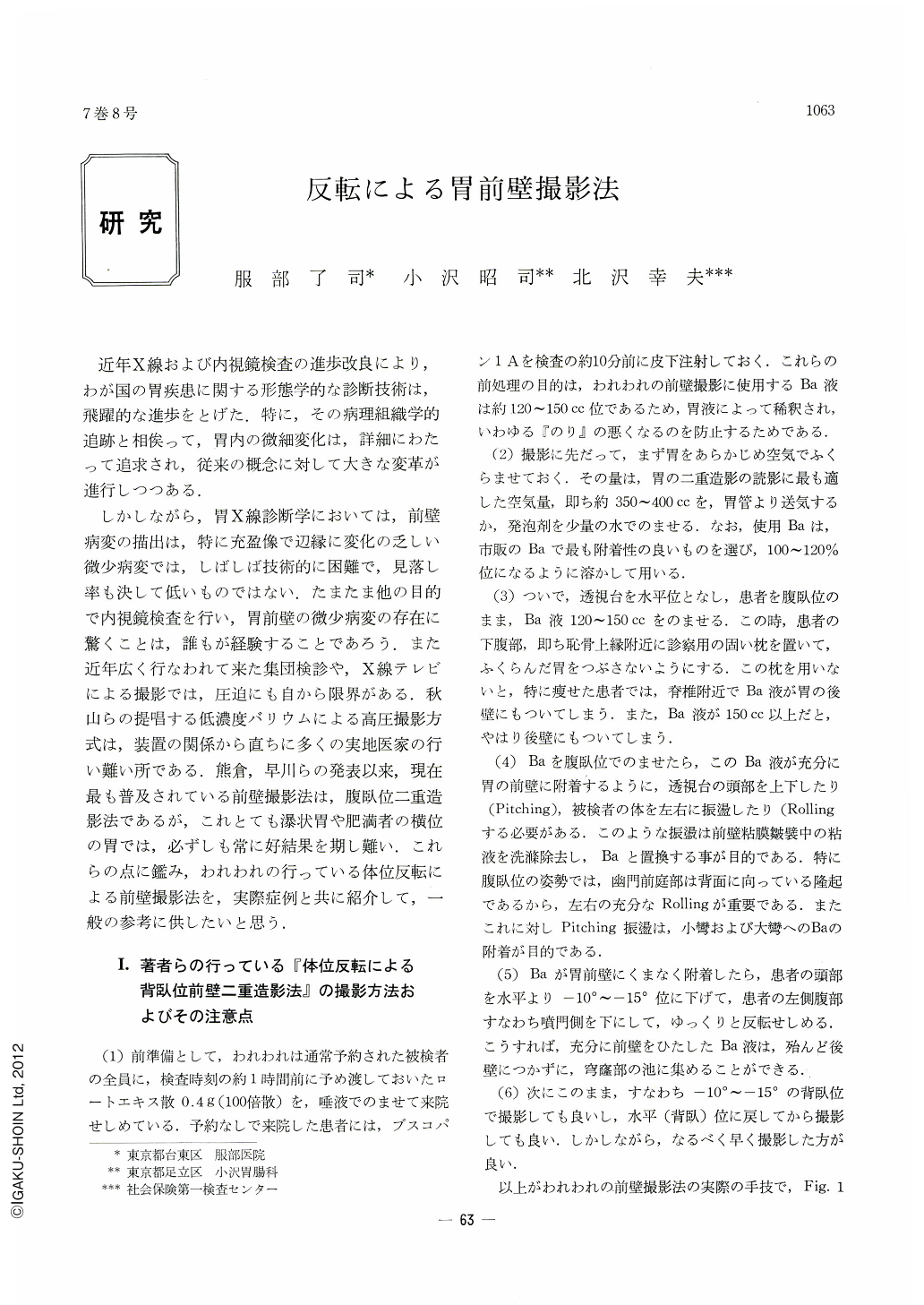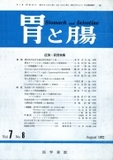Japanese
English
- 有料閲覧
- Abstract 文献概要
- 1ページ目 Look Inside
近年X線および内視鏡検査の進歩改良により,わが国の胃疾患に関する形態学的な診断技術は,飛躍的な進歩をとげた.特に,その病理組織学的追跡と相俟って,胃内の微細変化は,詳細にわたって追求され,従来の概念に対して大きな変革が進行しつつある.
しかしながら,胃X線診断学においては,前壁病変の描出は,特に充盈像で辺縁に変化の乏しい微少病変では,しばしば技術的に困難で,見落し率も決して低いものではない.たまたま他の目的で内視鏡検査を行い,胃前壁の微少病変の存在に驚くことは,誰もが経験することであろう.また近年広く行なわれて来た集団検診や,X線テレビによる撮影では,圧迫にも自から限界がある.秋山らの提唱する低濃度バリウムによる高圧撮影方式は,装置の関係から直ちに多くの実地医家の行い難い所である.熊倉,早川らの発表以来,現在最も普及されている前壁撮影法は,腹臥位二重造影法であるが,これとても爆状胃や肥満者の横位の胃では,必ずしも常に好結果を期し難い.これらの点に鑑み,われわれの行っている体位反転による前壁撮影法を,実際症例と共に紹介して,一般の参考に供したいと思う.
After the examinee has been given orally 0.4 gr of 1% Extractum scopoliae, the stomach is distended with an appropriate amount of air (ca. 400 cc) sent into it by a vynyl tube or else formed by swallowing effervescent tablets. Next the fluoroscopic table is tilted to a horizontal position with the examinee prone. In order not to let the air escape from the stomach, we usually place a small cushion under the pubic bone, and then let the examinee swallow about 120~150 ml of 100% barium meal without change of posture. Then we tilt the table-top up and down (pitching) or let his body roll from left to right (rolling) both for several times for the purpose of letting barium meal adhere more fixedly to the mucosal surface of the anterior wall. After contrast medium has stuck to it, we then tilt the head further down from -10°to -15°. The examinee is then asked to roll onto his back with his left side down, i. e., the cardiac side down, barium meal now collecting in the mucus lake in the fornix. Many exposures of the anterior wall are then made.
This method is so simple and easy that even a novice can take good pictures. Cascade stomach often seen in the obese can be photographied as clearly as gastroptosis.
Changes on the anterior wall can be interpreted in the same way as those in double contrast method, because pictures on the anterior wall are due to tangent effect. It must be also taken into account that findings on the anterior wall do not have to be seen through the mucosa of the posterior wall since this method is solely a one-side photography of the anterior wall. In this respect, scrutiny and interpretation of pathologic changes here are simple and clear. However, one of the drawbacks of tangent effect, lies in the difficulty of delineating a gentle slope of the mucosal surface as in submucosal tumors. It is more suitable for depicting abrupt elevation or sudden depression. It is also unsuitable for good exposures of the anterior wall of the fornix, because in the supine head-low position barium meal assembles in the cardiac lake.

Copyright © 1972, Igaku-Shoin Ltd. All rights reserved.


